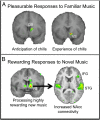From perception to pleasure: music and its neural substrates
- PMID: 23754373
- PMCID: PMC3690607
- DOI: 10.1073/pnas.1301228110
From perception to pleasure: music and its neural substrates
Abstract
Music has existed in human societies since prehistory, perhaps because it allows expression and regulation of emotion and evokes pleasure. In this review, we present findings from cognitive neuroscience that bear on the question of how we get from perception of sound patterns to pleasurable responses. First, we identify some of the auditory cortical circuits that are responsible for encoding and storing tonal patterns and discuss evidence that cortical loops between auditory and frontal cortices are important for maintaining musical information in working memory and for the recognition of structural regularities in musical patterns, which then lead to expectancies. Second, we review evidence concerning the mesolimbic striatal system and its involvement in reward, motivation, and pleasure in other domains. Recent data indicate that this dopaminergic system mediates pleasure associated with music; specifically, reward value for music can be coded by activity levels in the nucleus accumbens, whose functional connectivity with auditory and frontal areas increases as a function of increasing musical reward. We propose that pleasure in music arises from interactions between cortical loops that enable predictions and expectancies to emerge from sound patterns and subcortical systems responsible for reward and valuation.
Keywords: auditory cortex; cognition; functional imaging.
Conflict of interest statement
The authors declare no conflict of interest.
Figures



References
-
- Conard NJ, Malina M, Münzel SC. New flutes document the earliest musical tradition in southwestern Germany. Nature. 2009;460(7256):737–740. - PubMed
-
- Darwin C (1871) The Descent of Man, and Selection in Relation to Sex (John Murray, London)
-
- Darwin C (1887) The Life and Letters of Charles Darwin (John Murray, London)
-
- Hauser MD, McDermott J. The evolution of the music faculty: A comparative perspective. Nat Neurosci. 2003;6(7):663–668. - PubMed
-
- Wallin N, Merker B, Brown S (2000) The Origins of Music (MIT Press, Cambridge, MA)
Publication types
MeSH terms
LinkOut - more resources
Full Text Sources
Other Literature Sources

